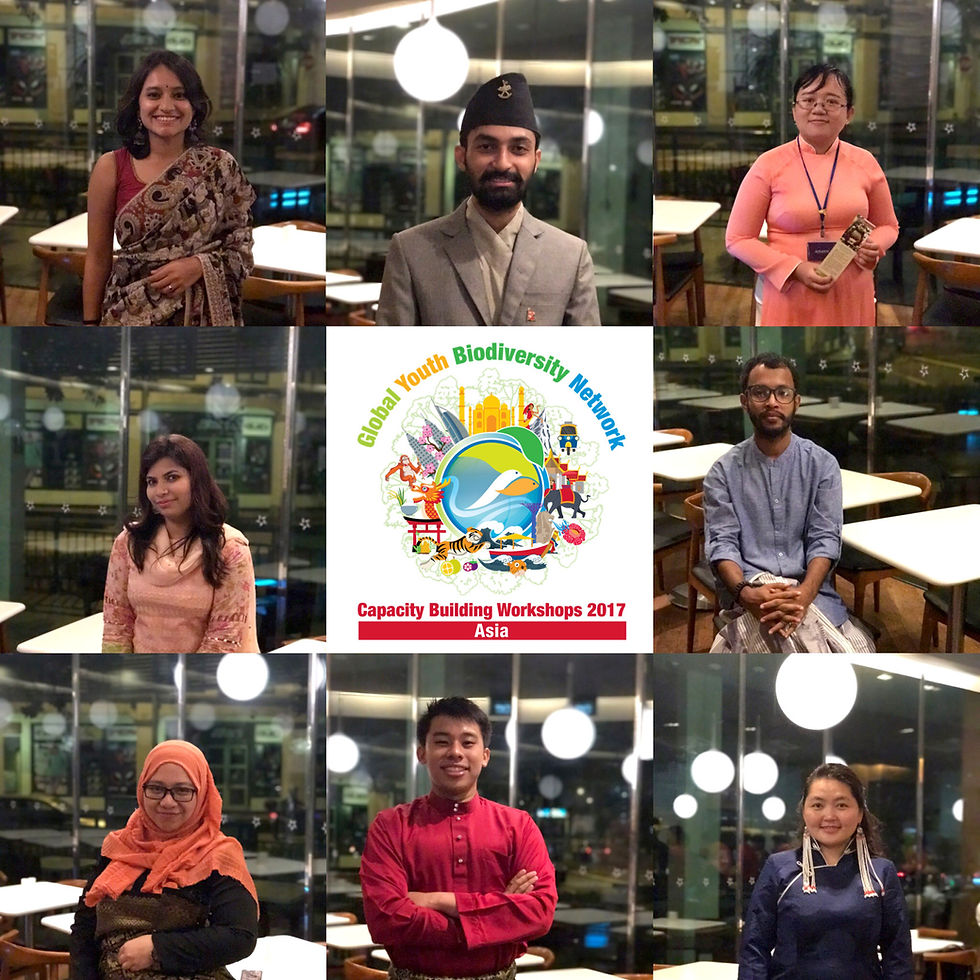Three takeaways from the Global Youth Biodiversity Network’s Asia Capacity Building Workshop
- gybn.web
- Jun 20, 2017
- 4 min read
By Mohammad Arju, Bangladesh
Hello people, who are reading this post, please be informed that on May 27 we’ve just wrapped up one of the most important events in Asia this year. I know, most of you never heard of it, but don’t be surprised; we know, relying on mainstream media as the only source of information has its own limitation- in many cases, the media fails to report on real important things.
So, please let me convince you about how the recently held Global Youth Biodiversity Network's Asia Capacity Building Workshop will shape the future of Asia and the Ocean planet.
THE HOMEWORK

One of my fellow participants at the workshop, Naseem Sultani from Afghanistan already written about it; the week-long workshop held in Singapore (with generous support from Singapore’s National Parks Board and Japan Biodiversity Fund) had a wide range of participants from the Central, South, Southeast, West and East Asia, and all of them are back to their home countries with a very specific homework. And the homework is not just about same-old-same-old romantic environmentalism about biodiversity; it is not about photogenic environmentalism of just holding another conference. The organizers were very clear about it, and this policy position was well reflected in all of the training sessions of the workshop (See the Schedule: PDF File).
The workshop was designed to train the youth leaders in real down-to-earth efforts for utilizing the already available multi-national process and mechanism (Convention on Biological Diversity, for example) on local, national and regional level to minimize the impact of market-economy on the diversity of life our planet hosts, and eventually help the governments in successful drafting and implementation of National Biodiversity Strategies and Action Plans (NBSAPs) to achieve Aichi Biodiversity Goals.
With this homework, the trained participants are out, therefore, more learning and real work, in their respective countries.
Using ‘System Thinking’ approach, they’ve built a scenario of current status and identified best possible leveraged to contribute to the conservation of biodiversity in Asia as a youth group. They’ve conceptualized several programs for the coming years to establish ASEAN and South and Central Asian sub-regional networks, to build a knowledge network, and to run a grassroots conservation program through Participatory Action Research led by youth organizations and fellows. In the coming months; they will design, develop and start implementing the programs.
So, in a brief, with the goal to secure more diversity of life on the planet, this workshop just deployed a team of well-trained youth leaders in the field to take part in political and decision-making processes at local, national, regional and international levels. The team’s work will certainly help the national governments in Asia to bring sustainability in the development process, also achieve many targets of the Sustainable Development Goals in the process and reconnecting the people with nature.
THE STRENGTH

In these times of growth-hungry economy devastating the people and the planet, being a conservationist means you are engaged in really down-to-earth activities to reverse the process. The Convention of Biological Diversity's stated role is to 'prevent and attack the causes of significant reduction or loss of biological diversity at source', you know it. And it's not easy, rather daunting, oftentimes exhaustive too. But this workshop was a forum where we met the people face to face who are building their lives around this daunting task, it was really comforting.
Even in places like Singapore, where the economic violence affected the social-ecological systems severely, things have started to change, we've met several groups of people who are working for reconnecting people with nature. Even within such an extremely modified landscape, as a result of orchestrated efforts by government authorities and citizen-science groups like Otter-Watch and NUS Toddycats, the Singapore River is now hosting at least two large families of the smooth-coated otter. We're aware that, there is no final victory in conservation, there will not be, but this sort of conservation-optimism story once again shows us the way.
And, it's not just that, you listen to others' stories, experience, and observation or go visit successful conservation initiative, which in some ways, or in many ways may be reasons to you, inform you about how people around the continent is bringing positive change for the conservation of biodiversity. One of the most important parts, for me, at the workshop was, I've learned a lot while articulating mine to others. Also, can sense that other participants were also re-discovering themselves by explaining their experience and ideas to others.
So, it is about self-motivation, as one of my fellow participants, Xu Waiting from Singapore was saying during their group presentation; ‘It’s the self-motivation what keeps you running to achieve what you believe in.’
WE THE PEOPLE

The most important aspect of the forum was, I should say, together, we can now think of ourselves as a people, the people for advancing conservation in Asia. By taking parts in a number of self-organizing tasks (System Thinking, Project Concept Developing for example), through the process of feedback and evaluation, we've already started to work collaboratively.
As a team, now we know about our internal resources, strength, expertise we can offer to each other; and we have already come up with concepts about how to get easier access to this team and keep collaborating.

A conservationist and journalist based in Bangladesh, Md Kutub Uddin (Mohammad Arju) is a Trustee of Save Our Sea.
Email: arju@saveoursea.social








Escort Service Mumbai provides professional and reliable companionship for individuals seeking a companion for various events or occasions. Their team of experienced escorts are known for their discretion, professionalism, and top-notch customer service.